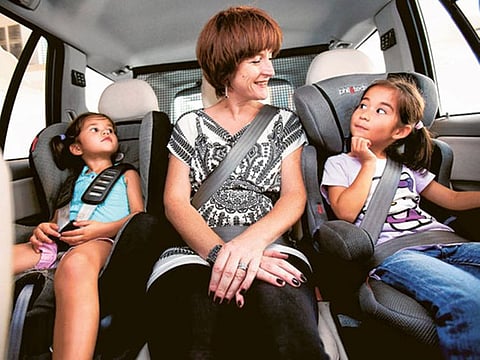Why motorists shouldn’t drive with little children in the front seat of cars
Child seats at the back are the safest place in a vehicle for children under 12

Travelling with little children in cars can be challenging. They never sit still, hate seatbelts and always want to be in the front seat.
I used to struggle when my kids were toddlers. They hated being strapped in the backseat when I insisted they wear seatbelts. When my daughter was an infant, keeping her still in a rear-facing child seat wasn’t easy. But I persisted. Now as grownups with driving licences, they understand the importance of safety in cars.
The same can’t be said of some parents. They take children’s safety in cars lightly. Don’t dismiss this as a careless remark. Look around, and you will see what I mean.
Child in a mother’s lap!
You will find mothers with infants on their laps, in the front seat. That’s not advisable even if they were in the rear seats. I won’t quote Newton’s First Law of Motion. But in the context of a moving vehicle, it simply means the occupants will continue to move at the speed of the car when it’s halted suddenly. Here’s where the seatbelts come handy: they restrain the passengers, preventing them from being hurled forward.
Now imagine what will happen to a child in a mother’s lap when their car, travelling at high speed, stops abruptly. I’m sure every mother must be holding her child firmly, but a speeding car poses different dynamics. The chances of the child being flung against the windshield are high. It’s entirely possible. If you don’t believe me, ask the experts.
The danger of airbags
This has been repeatedly stressed in traffic awareness campaigns. Yet, I see them with sickening regularity. Don’t these mother know of the consequences?, I ask myself. Are they ignorant? Or is it a complete disregard for the traffic rules and their safety?
Mothers should never keep infants in their laps while travelling in a car. They have to be strapped in a rear-facing car seat. Kids won’t like it, but over time, they will when they realise there’s no way out. Trust me, I’ve seen it happen with my daughter, who was hyperactive as a child.
I saw another scary sight the other day: two boys in the front passenger seat. According to UAE traffic laws, a child under the age of 10 cannot occupy the front seat of a moving car, and they should be at least 145cm tall. The age limit varies from country to country, but never below 10 years.
Why’s that? There are scientific reasons. All of them stem from the fact that children’s bones are still developing, putting them at risk during a crash.
Airbags pose the biggest threat. They are designed to protect people during crashes, so airbags generally deploy within 1/20th of a second at 320km per hour. It’s like an explosion. An average adult will survive but not children, whose bones are flexible and lack density. Airbag deployment will leave them with serious head injuries.
Why little kids are vulnerable
In road crashes, children sitting closer to the point of impact are likely to suffer severe injuries, which can be deadly. Their chances of survival are better in the backseat if they wear seatbelts.
The rules are similar worldwide. Rear-facing child seats are for infants, front-facing child seats are for kids 2-8 years, and booster seats are for older children (up to 12) if the seatbelts do not go over the centre of the shoulder.
In the UAE, drivers who violate the law on children in the front seat are fined Dh400 and slapped with four black points. That doesn’t seem to deter some parents. But beyond the fines, they must protect their children. Please strap the little ones in child seats at the back.
Children are precious.
Sign up for the Daily Briefing
Get the latest news and updates straight to your inbox








